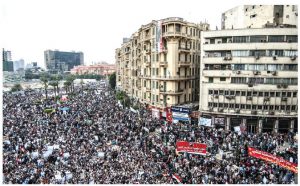
The Middle East and North Africa (MENA) region has captured the world’s attention in the 21st Century. The Arab Spring of 2011 illustrated how dynamic, grass-roots political movements, ignited by discontent and fuelled by social media, can completely transform societies in the blink of an eye. These events (resulting in revolutionary political shifts in places such as Tunisia, Egypt, Yemen, and Libya; along with major protests in Bahrain, Jordan, Iraq, Kuwait, Israel, Sudan, Algeria and Morocco) propelled the region into a period of unforeseen turmoil and transition, the effects of which are still being felt. Add to these developments the consistent threat of conflict and instability, extremism and terrorism, corruption and cronyism, along with an often indecipherably complex array of back-door politics, and we are only beginning to scratch the surface of what is currently happening in the MENA region. (The area comprises nearly 20 countries, depending on the definition being used. These countries are home to approximately 381 million people. The list generally includes Algeria, Bahrain, Egypt, Iran, Iraq, Israel, Jordan, Kuwait, Lebanon, Yemen, United Arab Emirates (UAE), Libya, Morocco, Oman, Palestine, Qatar, Saudi Arabia, Syria and Tunisia).
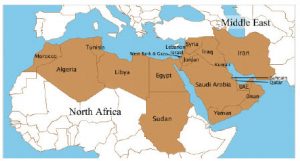
The region is a critical player in the global economy due to the massive petroleum and natural gas reserves to which it is home. In addition, the MENA countries have the distinction of having the highest levels of authoritarianism in the world. A complex picture emerges within this grouping of how forms of governance have influenced, and been influenced by, the political economy of the region.
While some states are undergoing violent conflicts, both internally and externally induced (for example Syria, Yemen, Libya, Iraq, Palestine), others remain stable, strong economic and political forces in the region (Saudi Arabia, UAE, Qatar.) Conflict diffusion and spillovers into Lebanon, Jordan, Turkey and others threaten regional peace and the stability of the international economic system.
While it is certainly difficult to make generalizations, an analysis of the political and economic trends characterizing the MENA region is useful to better understand why and how problems such as extremism, civil-war, refugee flows, state fragility and other forms of instability proliferate here. Because of the strongly interconnected global economy, such an analysis provides insight into the best ways in which local leaders and the international community can engage in order to push for the best possible path of development for a highly volatile (and highly diverse) region.
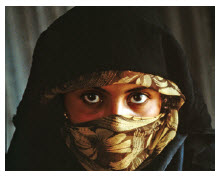
Governance in the Middle East and North Africa region
According to the World Bank, the majority of MENA’s population lives in middle-income countries that are doing relatively well, economically speaking. At the same time, there are certainly several outliers including, for example, Egypt, Morocco, Sudan, Yemen, Jordan and Sudan. Moreover, even if a country is doing well with regards to GDP, it does not follow that the average citizen enjoys his or her share of that wealth. The 2008/09 global financial crisis didn’t hit the region as hard as it did many other areas of the globe, largely due to the well-trained and highly skilled youth population and strong resource base. Yet, at the same time, the MENA region still sits as an authoritarian outlier when it comes to governance. For instance, Freedom House, a well-respected NGO that conducts research and advocacy on democracy, political freedom and human rights, has ranked the MENA countries as a whole in dead last position in their level of freedom since the 1980s; other popular indices agree. Moreover, MENA countries have undergone fewer political transitions than any other region; these countries are hence both unusually undemocratic and unusually stable.
Scholars and analysts have been continually stumped by this puzzle: What is it about the MENA countries that drives the propensity towards autocratic governments? Is there something inherent in the DNA of the region that predisposes such political systems to success? Or is it merely an accident of history? To what does MENA owe this extraordinary resistance to democracy?
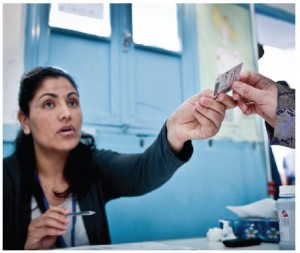
The resource curse: rentier states and democracy
While it is doubtful there will ever be a singular “magic bullet” explanation for this complex, context-dependent phenomenon, it still holds that there seems to be some particular set of forces that have served to entrench authoritarian systems of governance in the MENA region. One possible explanation relates to the political economy of the region. Note that a number of prominent studies have validated the linkages presented here. As previously mentioned, a number of the MENA countries are oil-rich (termed in the academic world as “rentier states” because they derive a substantial portion of revenues from the rent of indigenous resources to external clients). This means that leaders and elites with access to natural resource rents are able to act more autonomously than they would if they were reliant on a wider tax base for revenues. The general satisfaction of the people is therefore less important than it would be in a liberal democratic society.
In addition, the capacity of the state to employ strategies that crack down on dissent is also greater. Hiring police and security forces, running a state media conglomerate, banning alternative media and shutting down online social networks are all tactics that require significant resources. Without oil proceeds, MENA governments would be unable to engage in these types of repressive activities, which act to control and mitigate subversion within the populace. In addition, rentier states have little incentive to diversify economically. With such high rents pouring in through the trade of oil products, other industries are stifled, leading to shallow economic development and growth. This theory ties into the modernization effect, which supposes that as new industries mature, education levels will rise and specialize, leading to improved organization, communication and bargaining power in society.
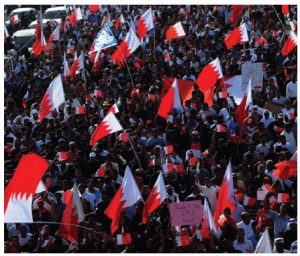
Finally, some rich Arab governments use this wealth to appease their populations through incentives. For example, free higher education, subsidies to travel and study abroad, low tax rates and other forms of patronage are strategies commonly employed by resource-rich governments. In turn, these incentives keep the population happy and even docile, lessening the desire for political change. All of these mechanisms help explain how the political economy of the MENA countries directly influences governance and keeps in power rulers who seemingly should not remain, given the global trends seen over the past few decades.
The Arab Spring: democratic desires or doubling down
If the entrenched authoritarian governments of MENA needed a push towards reform, the Arab Spring in 2011 provided that and more. No one — not political scientists, intelligence analysts, conflict early-warning researchers and certainly not the leaders of these countries themselves — saw the tidal wave of uprising, protest and instability approaching. Nevertheless, the spark that infused the tinderbox happened on an innocuous December 2010 day in Tunisia. A minor disagreement between a street merchant and a municipal street officer led a fruit vendor to set himself on fire. His self-immolation protest sparked some of the largest pro-democracy protests in history, and galvanized people across the region to take action against autocracy.
But have the events of the Arab Spring really represented a boon for democratic liberalization and reform in the MENA region? Perhaps not. Out of all the countries where real reform took place, only Tunisia still resembles a democratic system. Parliamentary and presidential elections in 2014 were remarkably peaceful and represent an historical achievement in the history of the country and the region. Democratic ideals have been enshrined within the new constitution and embody the pioneering role Tunisia has played in the region after the revolution. Despite relative peace within the country, terrorism and extremism still represent a threat, as evidenced by the attacks at the National Bardo Museum on March 18 this year, which killed at least 24 people, mostly foreign tourists. This target is just metres away from the Tunisian Parliament, demonstrating the ability of terrorists to hit the heart of this new democracy.
So even here, the transition has been rocky (as has almost every major political transition in history, this is one thing many forget or choose to ignore.) Recent polls show Tunisians do not see their country as a success story and that they would prefer more economic growth under a dictator over less economic growth in a democracy. On the other hand, Tunisia has made some advances, with the lifting of certain travel restrictions, greater academic freedoms and the establishment of new labour unions. The remainder of states have either reverted to autocracy or rolled back any measurable gains that were made.
The situation in Egypt — wherein the Muslim Brotherhood were voted to power only to be swiftly displaced by a military coup — encapsulates the larger trend. That trend was the quick rollback of democratic gains in the region with the help of security forces, past governments, ruling families and other political elites. Indeed, this trend was seen throughout the MENA region, with aspirations for free and fair democratic elections consistently suppressed through intimidation, violence, arrests and imprisonments.
Turning to the other countries where dictatorial leaders were cast away does not paint a rosier picture. Yemen was undergoing a contentious transitory process when Houthi factions deposed the president and took over the capital. Libya without Gadhafi has spiralled into low-level civil war, with deep-seated regional and tribal rivalries backed by autonomous militias ruling the day. In Bahrain, there was no change in leadership, but now all public opposition has been crushed. The government here has dissolved the Islamic Scholars Council of Bahrain and banned contact between political organizations and foreign officials. Clearly these new laws are aimed at preventing an organized opposition movement from developing. And finally there is the “neighbourhood of fear” effect — populations of MENA countries have observed how poorly revolutions in these places have turned out and fear ending up as the next Syria or Libya. Opposition movements in countries such as Jordan have retreated, preferring their monarchical system to the unknown.
One consequence of these developments is a move to extremism and terrorism. Radicalization broadly speaking — has been shown to be born out of isolation, helplessness and persecution. These risk factors are further exacerbated in the Middle East by the lack of jobs, anger at leaders for stifling of economic growth and the religious justification for violence based on a narrow interpretation of Islam pushed by radical Imams and other leadership figures. If MENA states continue to quell dissent, opposition groups may resort to guerrilla tactics as a means of forcing political change. Moreover, as the wars in Syria, Iraq, Libya and elsewhere rage on, more and more foreign fights are flowing to the area as masses of refugees flow in the opposite direction. Both have destabilizing effects and can exacerbate already precarious situations in neighbouring countries. The “bad neighbourhood effect” is well established and having neighbouring states in conflict increases the chances of state failure exponentially.
Another under-examined dynamic is the proxy wars which are fought covertly (and not so covertly) in the region. For example, in Syria we have the Assad regime propped up by support from Shia Iran and Hezbollah, and the rebels supported by the West and its Sunni allies such as Saudi Arabia and Qatar. Here, then, we see the Shiite-Sunni conflict playing out with powerful states on both sides funding destabilization in some cases and repression in others. In addition to Syria, countries such as Iraq, Iran, Lebanon, Pakistan, Saudi Arabia and Bahrain all suffer from sectarian tensions along this divide. Moreover, a number of the Gulf Cooperation Council states are involved in undermining any momentum towards democratic reform in states that are on the brink of change; they provide training and resources to their allies in these battles, hoping to continue their grip on power in the region.
The future of a region in flux
So what does all of this mean for the future stability of authoritarian governments in the MENA region? From the above analysis, cynicism appears to be the best bet. However, I would argue instead for cautious optimism going forward. The democratic transitions that occurred in other regions of the world were as messy, if not more, as what we are witnessing now in the MENA region. Furthermore, the underlying structural conditions that gave rise to the Arab Spring are not going away any time soon. These conditions include gender inequality (such as the inability of women to work outside of the home, drive, vote and participate in daily life as we know it in the West); an eschewing of modernism, economic development, and democracy; and the large youth bulge — where highly educated young people are unable to find work related to their training — is only growing, and along with it so, too, is resentment. For example, unemployment rates in the region at the time of the Arab spring were about 25 percent overall and about 40 percent for women. Since then, these statistics have not improved: 27.2 percent of youth under 25 are unemployed in the Middle East and 29 percent in North Africa; this is more than double the global average. These youth are generally well educated and remain expectant of good jobs with fair wages; something that has yet to materialize for reasons discussed elsewhere in this article.
The growth and spread of information technology, in particular social media, is having an unprecedented effect on these societies as well. Much ink has been spilled on how the Arab Spring was a “social media revolution,” which may or may not be an exaggeration. Yet it is inarguable that communication technology is having an effect on the spread of democratic ideals, fuelled by a desire to shake off decades of oppression, injustice, corruption and broken promises by autocratic governments. As younger generations become more aware of how others in the world are living and their relative deprivation in terms of freedom of expression and political dissent, they will strive all the more for better and more equitable systems.
To be sure, the current mechanisms through which authoritarian governments keep control will not last forever. Policy-makers in the West have little influence on the complex dynamics at play in the MENA region; however, Western nations must be positioned to encourage and support such transitions through the will of the people who are struggling for democratic ideals.
Joe Landry is a Social Sciences and Humanities Research Council’s (SSHRC) Joseph-Armand Bombardier Canada Graduate Scholar at the Norman Paterson School of International Affairs at Carleton University. He is currently managing editor of the Canadian Foreign Policy Journal and research assistant with the SSHRC-funded Country Indicators for Foreign Policy project.





